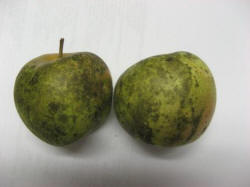|
 In our area, we have two types of ragweed. The most noticeable
is giant ragweed. Giant ragweed, also called horseweed, and it
can grow well over 10 feet tall. It is very noticeable as one of
the few weeds that grows taller than our Illinois corn. The
other type of ragweed is common ragweed. It is generally less
than six feet tall, and not nearly as noticeable. In our area, we have two types of ragweed. The most noticeable
is giant ragweed. Giant ragweed, also called horseweed, and it
can grow well over 10 feet tall. It is very noticeable as one of
the few weeds that grows taller than our Illinois corn. The
other type of ragweed is common ragweed. It is generally less
than six feet tall, and not nearly as noticeable.
Ragweeds tend to bloom in late summer. The period can range from
mid-August to mid-September. They put out a lot of pollen when
they bloom. The amount of pollen is one problem, but the shape
of the pollen is the other. The shape of the pollen is more
jagged and sharp along the edges, making it more of an irritant
than other types of pollen.
Add in the usual ragweed problems, alternating wet and dry
conditions, and early leaf drop, and we have the recipe for an
allergy sufferer’s nightmare. There are also several leaf molds
that are at work, and that compounds the allergy problem.

What can you do? First, try to eliminate ragweed in your
particular area. Two, avoid the mid to late morning period in
the great outdoors. This is when more pollen is released. Three,
you can stay indoors (or office or car) with air conditioning.
And, if your problems are particularly troublesome, talk to your
doctor. There are prescriptions and over-the-counter that can
help alleviate at least some of the symptoms. My doctor told me
this week this particular season was the latest in the “worst
ever.” At least, there is the old statement of “misery loves
company” and you’re not alone.

[to top of second column] |

Sooty Blotch of Apple
Apple development seems to be running ahead of normal this year.
Sooty blotch and flyspeck are caused by different fungi that
commonly occur together on the same fruit. The sooty blotch
fungus causes surface discoloration with black spots or blotches
which can be a fourth of an inch or larger. These spots may run
together, making the apple appear to be covered with something
like charcoal dust. This disease is more superficial than
anything, since it is only on the skin. Vigorous rubbing, or
scrubbing, will remove the black discoloration. If you want to
be sure, you can always peel the apples.

This disease is most common with moderate temperatures and wet
weather. Wet weather can include heavy dews which don’t get
dried out very well. Anything that cuts down on air circulation
helps promote sooty blotch. Pruning and thinning fruit will help
improve air circulation, and lessen the disease problems.
The best chemical control program is to use a multi-purpose
fruit tree spray, containing captan fungicide, as a
preventative. For this disease, it is recommended to begin by
early June, and continue the program until harvest. For the
organic gardeners, sulfur will help some. However, it is not as
good as the captan. Remember many diseases are preventable in
home fruit production, but they are not curable. Once you see
the problem, it becomes a to-do list item for next year.
[By JOHN FULTON, COUNTY EXTENSION
DIRECTOR SERVING LOGAN, MENARD, AND SANGAMON COUNTIES] |